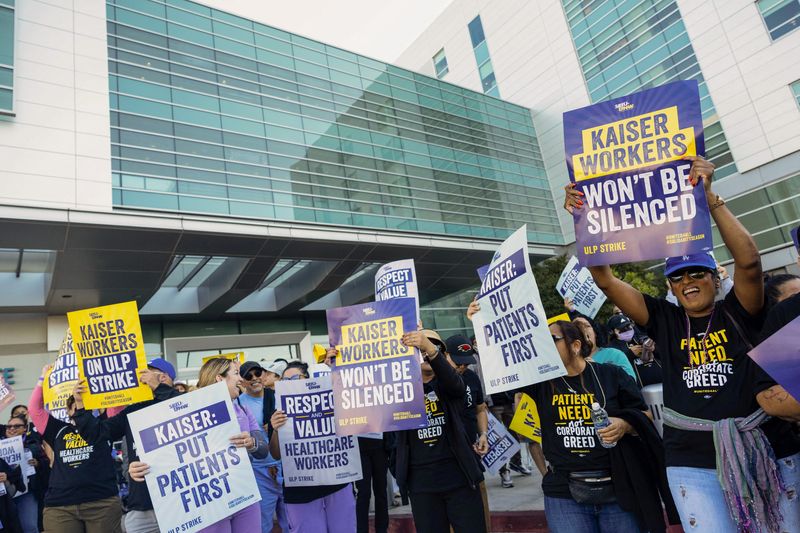Kaiser healthcare workers’ 3-day strike winds down, parties agree to more talks
By Steve Gorman and Ahmed Aboulenein
LOS ANGELES (Reuters) – A 72-hour strike by 75,000 healthcare workers against Kaiser Permanente drew to a close on Friday as both sides in the labor dispute agreed to resume stalled contract talks next week while union officials warned of possible further walkouts to come.
Acting U.S. Labor Secretary Julie Su, who played a role as mediator during an all-night negotiating session last week, will return to California to “assist the parties in advancing talks” when they return to the bargaining table next week, the Labor Department announced.
Nurses, medical technicians and support staff at hundreds of Kaiser hospitals and clinics in California, Oregon, Washington state, Colorado, Virginia and the District of Columbia walked off the job on Wednesday morning in the largest strike ever to hit the U.S. healthcare sector.
The labor clash has centered on workers’ demands for better pay and measures to alleviate chronic staffing shortages and high turnover of personnel that union officials say has undermined patient care at Kaiser, one of the largest medical employers in the United States.
The union coalition bargaining with Kaiser said on Friday that “outsourcing of critical healthcare duties” has become another key point of contention in the dispute.
Kaiser has said its hospitals and emergency departments have remained open during the walkout, staffed by doctors, managers and “contingency workers.”
The strike has pushed Kaiser to the forefront of growing labor unrest in the healthcare industry – and across the U.S. economy – driven by the erosion of workers’ earning power due to inflation and pandemic-related disruptions in the labor force.
A last-ditch, marathon bargaining session in which Su sought to broker a deal on the eve of the strike failed to yield a settlement, and the talks broke off on Wednesday.
Kaiser, a leading nonprofit hospital network and managed-care organization, said then that progress had been made on some unspecified issues. But union officials countered that they were left waiting for a “meaningful response” from company executives to all their biggest demands.
After a day of little apparent communication between them, the two parties announced on Friday they had agreed to resume negotiations on Oct. 12.
The current strike was set to conclude at 6 a.m. local time on Saturday, as healthcare workers are barred by law from extending the duration of a walkout unless 10 days’ advance notice is given.
UNION WARNING
However, the union coalition warned on Friday of that labor peace would be short-lived if “Kaiser executives continue to commit unfair labor practices and bargain in bad faith.”
“It is possible that the coalition will issue a 10-day strike notice after Saturday, which could lead to further striking by Kaiser employees after those ten days,” it said.
Kaiser’s previous four-year labor contract expired on Sept. 30, after nearly six months of labor negotiations.
The union coalition has accused the company of failing to address a prolonged staffing crunch that has left employees feeling overworked and underpaid while compromising patient care.
The company has acknowledged staffing shortages plaguing the entire sector, a consequence of occupational “burnout” from the COVID-19 pandemic, leading to more than 5 million medical workers leaving their jobs.
Short staffing and high turnover were among the final sticking points left to be settled, as were union demands to limit outsourcing of jobs to vendors and third-party subcontractors.
Union officials have said pay increases was another major point of contention, while the company argued that it already led competitors in total compensation packages in every market where Kaiser operates.
Unions across the United States have grown bolder in their demands in the past two years, pressing for higher wages and better benefits in a tighter post-pandemic labor market.
Government data shows 2023 is already the busiest year for strikes overall since 2019, with nearly 309,700 workers involved in work stoppages through August this year.
The largest number of workers previously involved in a major walkout in the healthcare sector was 53,000 in 2018, according to the U.S. Bureau of Labor Statistics,
The coalition of eight unions representing medical professionals and support staff at Kaiser insisted the company commit to hiring at least 10,000 new workers, in addition to filling some 4,000 recent vacancies.
Kaiser nationwide serves some 13 million patients and employs 68,000 nurses and 213,000 technicians, clerical workers, and administrative staff, alongside its 24,000 doctors.
(Reporting and writing by Steve Gorman in Los Angeles; additional reporting by Ahmed Aboulenein in Washington and Bhanvi Satija in Bengaluru; Editing by Bill Berkrot and Robert Birsel)












 Bitcoin
Bitcoin  Ethereum
Ethereum  Tether
Tether  XRP
XRP  USDC
USDC  Lido Staked Ether
Lido Staked Ether  Dogecoin
Dogecoin  TRON
TRON  Cardano
Cardano